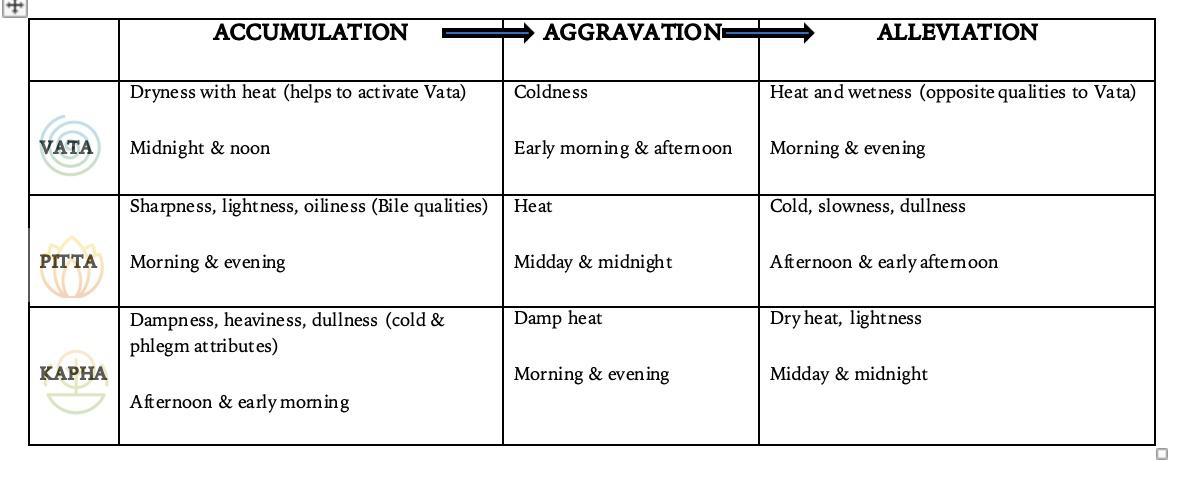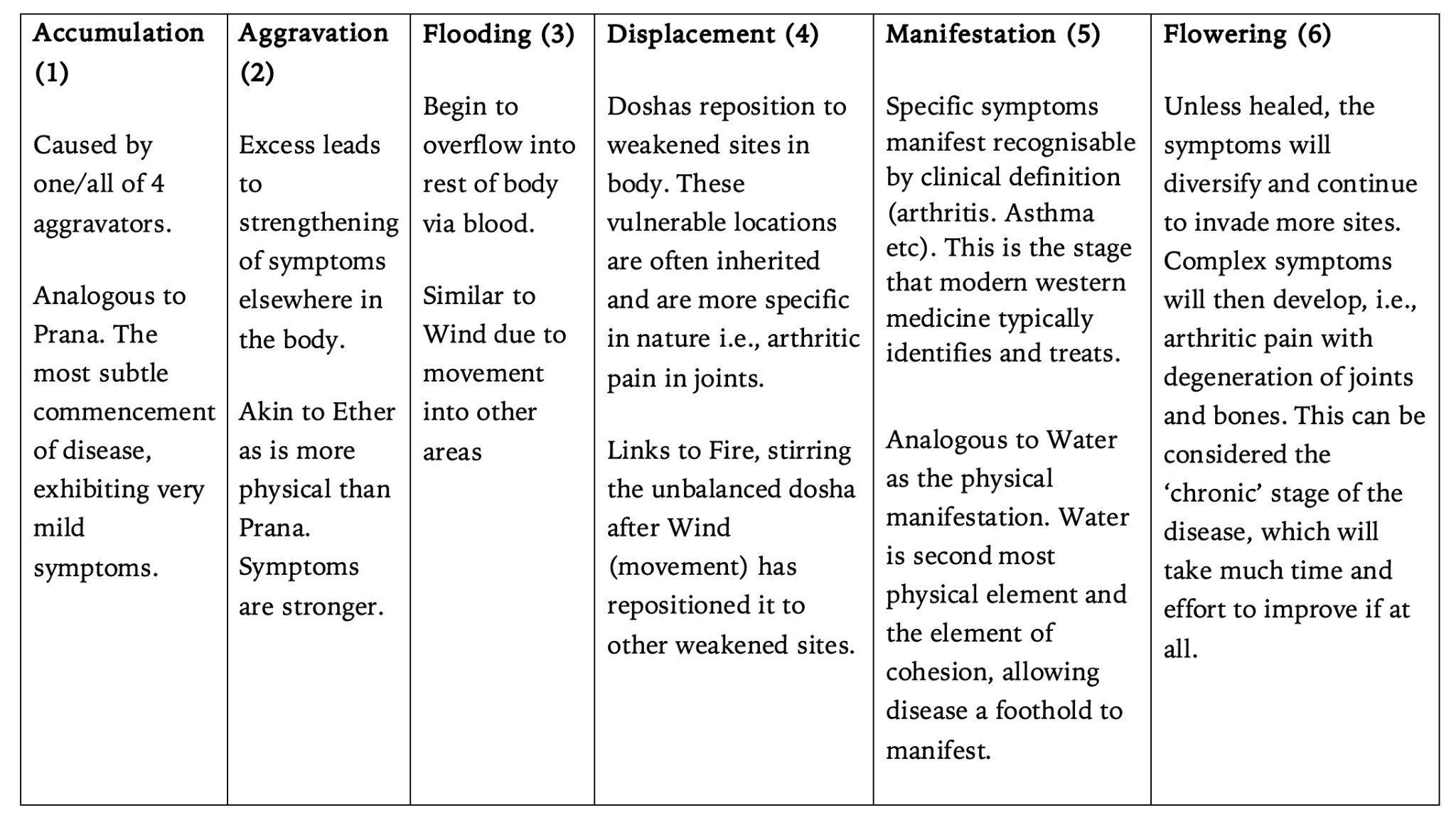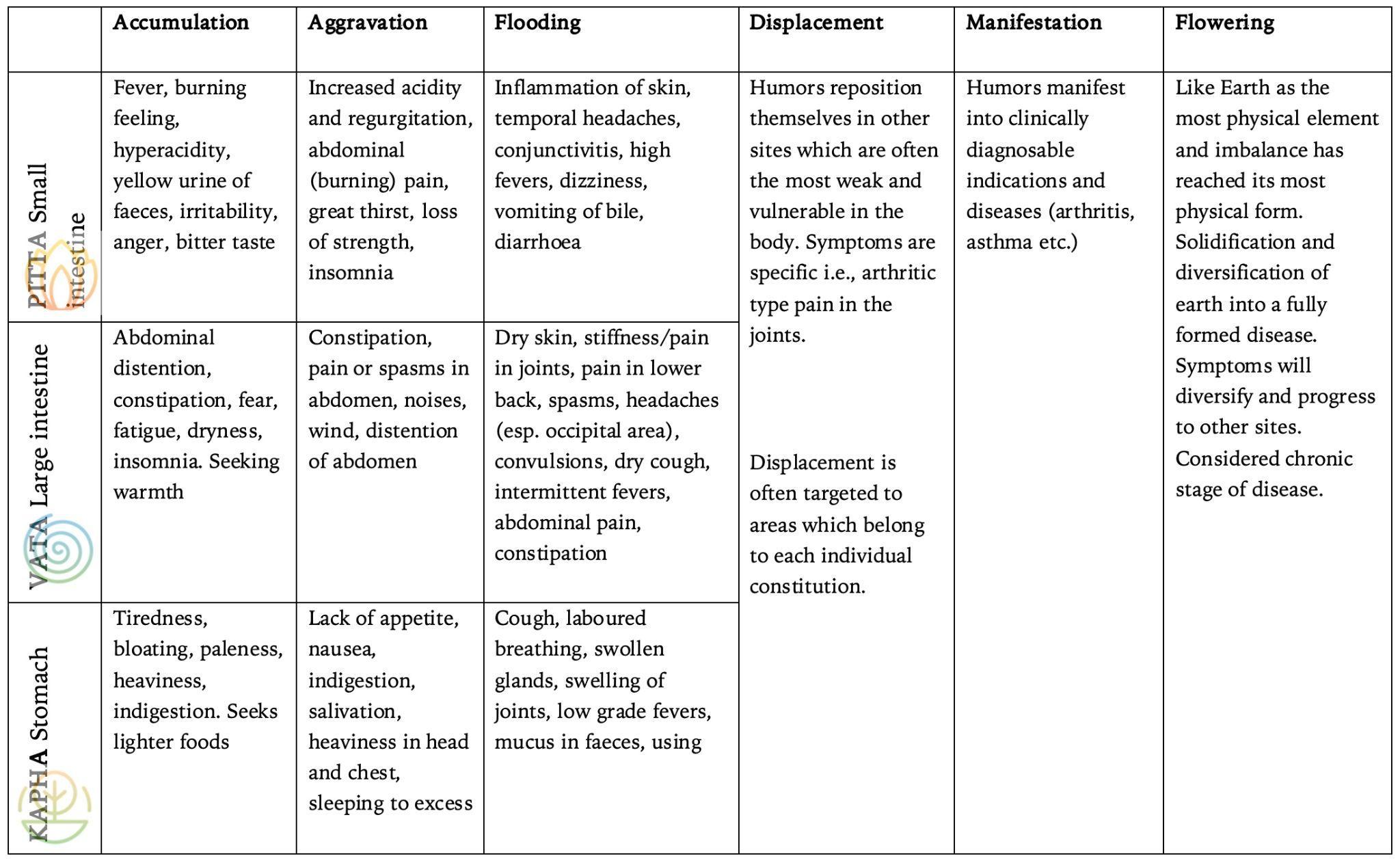Introduction to the Ayurvedic Process of Disease
The disease process typically follows three paths akin to the Tridoshas and so there is a strong correlation to the Five Elements and their cycles/wheels of interaction. The nature of the doshas’ pranic energy is to continuously rise and fall as per its pranic clock; prana is received, increases, peaks, and then decreases. A dosha’s energy can also increase by the absorption of Prana through external factors, i.e., a person of a Pitta constitution may increase this humor by eating acidic foods. This process/path is referred to as Samchaya – the increase of accumulation of a humor.
The second path, Prakopa, is caused by aggravation, exhibiting symptoms related to the dosha impacted (i.e., excess gas for Vata). The third path, Prashama, is the alleviation stage which signals the point where a person has moved from an aggravated state back to its former level.
The below table outlines this process for each dosha as well as the timings for which provocation occurs:

DISEASE PROCESS
There are main sites within the body that house the doshas; Vata primarily resides in the large intestine; Pitta in the small intestine; and Kapha in the stomach. Regarding the disease process, there are three influencing factors that can influence whether said dosha is in a state of excess or deficiency. These three factors are:
1. Dislike to qualities which increased them (foods/substances causing accumulation)
2. Need for substances of opposite characteristics (which will decrease the dosha)
3. Movement out of their primary site and invasion of other organs and tissues (aggravation exhibiting symptoms within the primary organ and/or other tissues and organs.
For example, a person of a Vata type constitution suffering from a Vata dysfunction will dislike cold and dry types of food and be attracted to substances which normally decrease the humor. * Continuation of an aggravated Vata will then invade other organs and tissues, like the joints, causing dryness and pain in this area.
All doshas must be ‘alleviated’ and returned to their site of accumulation to ensure eradication of the disease. Pancha-Karma is the Ayurvedic term for a treatment that cleanses the primary sites of the Doshas (stomach, small intestine, and large intestine). Combined with acupuncture, the doshas are then alleviated and returned to their original state. Whilst an effective treatment for balancing the doshas, Pancha Karma is not suitable for all conditions, contra indications include old age, childhood, ulcerative colitis, diarrhoea etc. In these instances, acupuncture without Pancha-Karma is advised.
* Taste cravings can provide a helpful diagnostic insight, if you crave something bitter/citrus this could suggest a need to detoxify the Liver.
AGGRAVATION OF THE HUMORS
Ayurveda recognises four core aggravators that catalyse imbalance in the doshas. The following are listed in order of how quickly the doshas and the human body are affected.
1. Mental & emotional factors (stress) – owing to the nature of our society, the popularity of social media platforms and the pressures we face to ‘succeed’, anxiety, anger, fear, hate, frustration are only some of the negative common emotions we feel on a regular basis. In many cases this can lead to stress, which is now the main cause of disease/bodily dysfunctions in the developed world.
2. Diet – Whilst there has been more awareness over the last decade about organic produce, balanced diet, less meat etc. our relationship with food is still significantly flawed. Factors like; the rise of fast foods; the use of microwaves; and the fault in the transfer of knowledge about seasonal eating all play a part in negatively affecting the pranic energy we receive from food. Consequently, prana becomes deficient in the human body which aggravates the doshas and their related organs and causes dysfunction and disease.
3. Lifestyle – Similarly to the societal factors affecting our mental health as outlined above, our lifestyle is operating at a faster pace than it was 100 years ago. Technological advancements have brought about an immediacy of accessibility, creating a demand and addiction for distraction. Eating whilst watching t.v., overindulgence in physical exercise, prolonged work hours, screen addiction, these all create an over stimulation of our senses which offers no time for meditation or reflection.
4. Environmental factors – Relates to factors such as living standards, pollution, antioxidants etc. The weather is another more natural environmental factor. When we are subjected to excess heat in the summer months, this can aggravate Ether and consequently all related organs. The seasons are a natural means of diagnosis and highlight the internal condition of the body. The appearance of cold for example, is a natural indication that the patient has a build-up of toxins and unwanted material which the body needs to expel. In today’s period of extreme climate change, the weather is becoming even more excessive, and we are experiencing much hotter summers than ever before. Consequently, it has never been more important to pay attention to the weather. We can divide weather into 6 subcategories which, when in excess, can aggravate the related humor:

Considering the prevalence of the above factors in the world we operate in today; it is even more crucial that we abide by the following set of principles to avoid health disturbances.
1. The practice of ‘letting go’ of negative emotions like anger and hate. The loving-kindness meditation is a wonderful practice that facilitates this.
2. Strive for a more organic and balanced diet. Ideally, eating seasonally and locally where possible.
3. Meditate to slow down the mind. This could be in the form of Yoga, Tai Chi, or simply breathing deeply. There are many apps now like Calm, Headspace that offer guided meditations.
4. Take appropriate action to balance the doshas during the various seasons of the year, such as a massage or acupuncture treatments. i.e., Pitta should be pacified during the summer heat, Kapha could be aggravated during winter and spring, and Vata for autumn.
SIX STAGES OF DISEASE
The below table outlines the six stages of diseases, what occurs within the doshas during each stage and the symptoms that manifest as a result. This mirrors The Wheel of Destruction as discussed earlier:


TYPES OF DISEASES
There are three types of diseases that roughly correspondent to the three doshas and are progressive in order. A healthy individual is considered someone with a strong immune system and a balanced nervous system. These two systems are symbiotic in nature; one cannot function correctly without the correct functioning of the other. The immune system has the power to repair and destroy unwanted foreign bodies, and the nervous system (specifically the Autonomic Nervous System) is the communication network by which the immune system can properly function.
The nervous system must be balanced before health can be achieved. Impairment/suppression of the nervous system can similarly impair the immune system, which is why under general anaesthetic the patient must be kept in a totally sterilised environment due to their temporary lowered immunity. These conditions are not always necessary if the patient receives acupuncture analgesia during an operation. In this instance, the immune system is still functioning via an alert nervous system everywhere else in the body.
The 3 types of diseases are:
1. Acute Diseases
Acute diseases relate to the natural reactions that occur when the body is attempting to heal itself after an imbalance has occurred, i.e., diarrhoea, vomiting, sneezing, belching, fever, inflammation, swelling, congestion, redness, or pain. During this process, the body has gone into high alert to purge the body of the accumulated poisons. We see this commonly in childhood diseases like chicken pox, measles, mumps, whooping cough etc, all natural purging reactions which are necessary to build a strong immune system. Ayurveda understands that the occurrence of childhood diseases is caused by the need to shed its temporary protective system inherited from the mother to establish and develop their own independent systems of protection.
2. Chronic diseases
Chronic diseases are the progression of unresolved acute diseases and correlate to serious imbalances, often occurring from suppression of the acute symptoms (i.e., drugs like anti-biotics to mask the symptoms of colds). The immune system cannot then react accordingly so its natural symptoms of redness, inflammation, pain, swelling and restriction in function to aid repair are not catalysed. Self-perpetuating in nature, chronic diseases (like asthma, bronchitis, acne) require treatment to eliminate or will develop in seriousness.
3. Chronic Degenerative Diseases
The most serious of all diseases, chronic degenerative diseases (i.e., cancer, Alzheimer’s etc) are the final development of untreated chronic diseases, typically occurring as a result of suppressed acute symptoms via the immune system and are often considered life-threatening. This is supported in cancer statistics found in countries practising western culture & medicine (1 in 3) compared to parts of Tibet and South America that do not adopt western medicines and where cancer is virtually unheard of.
Treatment for chronic degenerative diseases involves sensitizing the immune system, taking the disease back into the chronic stage. It will then turn back to the acute stage before health can be restored.
Ayurveda considers Ojas as the subtle essence of the immune system. Low Ojas refers to immune deficiency, which ultimately leady to chronic and degenerative diseases. Outside of these four core aggravators, Ayurveda recognises that extreme external factors such as contagious epidemics can interfere with the health process and imbalance of doshas. However, Ayurveda also recognises that epidemics will generally affect those with a lowered immune system. This has been most recently evidenced by the resent Covid pandemic, with death statistics largely correlating to older patients or vulnerable patients with weakened systems.
